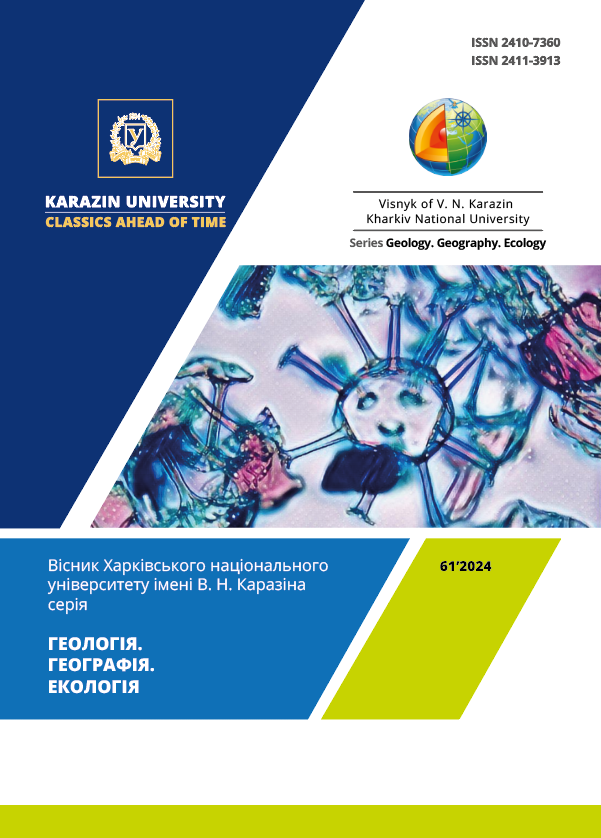Transformative capabilities of geological processes
Abstract
Statement of a general problem. Geological processes create the dynamic structure of the Earth. This structure is composed of a hierarchical system of geological bodies. But the relationship of geological processes with this system of geological bodies has not yet been analyzed.
Analysis of the latest research and publications. Back in the 19th century it has been established that geological processes come down to the transformation of some geological bodies into others in stages: 1) destruction of the original substrate; 2) recombination of fragments; 3) constructing new geological bodies from them. A hierarchical structure of many geological bodies has been revealed, including successive ranks: 1) mineral, 2) rock, 3) formational and 4) Earth shells. The entire variety of geological processes is grouped into 5 types according to the mechanisms of their occurrence and the results obtained: 1) terrigenous, 2) organogenic, 3) metamorphic, 4) crystallization (magmatic and cryogenic), 5) chemogenic and metasomatic.
An unresolved part of the overall problem. Bodies that are destroyed and formed as a result of the process necessarily belong to one or another rank. The rank possibilities of transformation of geological bodies by geological processes have not yet been analyzed.
The purpose of the article is to analyze the transformative capabilities of geological processes in the aspect of those objects that enter the geological process, are transformed in it and form the final result.
Research methods. The basis of the comparative analysis was the ranks of geological bodies and non-geological ranks of objects (molecular and atomic), since they also participate in geological processes. Combinations of bodies of different ranks at different stages of the process were depicted in the form of a diagram - a matrix. Matrices of individual processes allowed us to move on to the analysis of this type of process. After this, the conversion capabilities of different types were compared.
Main results of the study. First, the transformative capabilities of each process were considered separately, then the processes of a given genetic type were compared, then the types were compared with each other. Terrigenous processes do not form new mineral individuals and are capable of forming a planetary shell (stratisphere) only together. Organogenic processes form new minerals and rock bodies, but only benthos can form segments of the planet (biogenic bands). Metamorphic processes form new minerals, rocks and formations, and mantle flows and folding processes form planetary shells. Magmatic and cryogenic processes can not only form new minerals, but also form planetary shells. Chemogenic and metasomatic processes, forming new minerals, rocks and formations, form a planetary metasomatic shell only together, and not separately.
Scientific novelty. Based on the theory of the structure of geological bodies, matrices of their transformations in geological processes have been developed. Each geological process has its own matrix. The matrices made it possible to compare the transformative capabilities of individual processes and all five genetic types of processes with each other.
Conclusions. The transformative capabilities of geological processes and their types differ. In particular, this concerns the possibilities for the formation of new minerals needed by industry. Such an empirical generalization can serve as the basis for improving the theory of ore formation.
Downloads
References
Aleksandrov Yu.V. (1982). Introduction to planetary physics. Kyiv, Higher School, 304.
Allison A., Palmer L. (1984). Geology. M., Mir, 450.
Aplonov S.V. (2001). Geodynamics. Ed. St.-Pt. University, 345.
Goryainov S.V. (2001). Hierarchy of natural geological bodies. Kharkiv, 564.
Goryainov S.V. (2010). Formalization and confirmation of the law of change in the force organization of newly formed natural bodies. Visnyk of V. N. Karazin Kharkiv National University, series "Geology. Geography. Ecology", (32), 18-26.
Ivanik O.M., Menasova A.Sh., Krochak M.D. (2020). General geology. Tutorial. Kyiv, 205 [in Ukrainian].
Korago A.A. Introduction to biomineralogy (1992). St.-Pt., Nedra, 280.
Markov A.V. (2018). The birth of complexity. Evolutionary biology today: unexpected discoveries and new ques-tions. Litres (LitRes).
Ostrovsky V.E., Kadyshevich E.A. (2007). A generalized hypothesis of the origin of the simplest elements of living matter, the transformation of the primary atmosphere and the formation of methane hydrate deposits. Uspekhi fiziskikh nauk, 177, 2, 183-206.
Paranko I.S., Sivoronov A.O., Yevtekhov V.D. (2003). General geology. Tutorial. Kryvyi Rih, Mineral, 464 [in Ukrainian].
Pospelov G.L. (1973). Paradoxes, geological-physical essence and mechanisms of metasomatosis. Novosib., Nauka, 355.
Rosenbush G. Descriptive petrography (1934). L., Gorgeoneftizdat, 720.
Slenzak O.I. (1984). Local structures of Precambrian tension zones. Kiev, Scientific opinion, 104.
Sorokhtyn O.G., Ushakov S.A. (2002). Development of the Earth. Textbook. Ed. V.A. Sadovnychy. M., MSU Publish-ing House, 560.
Chikov B.M. (1999). Shear stress-structure formation in the lithosphere: variations, mechanisms, conditions (over-view of problems). Geology and geophysics, 9, 3-39.
Aadland T., Sadler P.M., Helland-Hansen W. (2018). Geometric interpretation of time-scale dependent sedimenta-tion rates. Sedimentary Geology, 371, 32-4. https://doi.org/10.1016/j.sedgeo.2018.04.003
Gingerich Philip D. Rates of geological processes (2021). Earth-Science Reviews, 220. https://doi.org/10.1016/j.earscirev.2021.103723
Ingebritsen St. E., Sanford W. E., Neuzil Ch. E. (2006). Groundwater in Geologic Processes. Cambridge University Press. https://doi.org/10.1017/9780511807855
Melosh H.J. Impact cratering: a geologic process (1989). Oxford University Press, NY, 245.
Electronic resource. URL https://v-kosmose.com/fotografii-kosmosa/fotografii-obektov-solnechnoy-sistemyi/

This work is licensed under a Creative Commons Attribution 4.0 International License.





